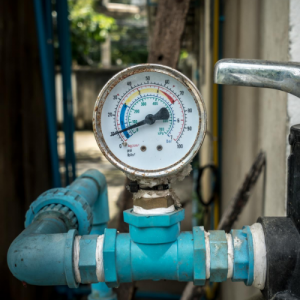Are you currently hunting for ideas involving 4 Ways to Troubleshoot Low Water Pressure?

Low water pressure in your house can be a discouraging trouble, influencing every little thing from bathing to washing dishes. If you're experiencing weak water flow, there are several feasible causes and solutions to discover. In this guide, we'll talk about common factors for low water pressure and useful steps to resolve the problem successfully.
Introduction to Low Water Stress
Low water pressure takes place when the flow of water from your taps, showers, and various other fixtures is weaker than common. This can make daily jobs more tough and much less efficient. Recognizing the root causes of low tide stress is important to locating the best remedy.
Usual Root Causes Of Low Tide Pressure
Faulty Stress Regulatory Authorities
Pressure regulators are in charge of preserving regular water pressure in your home. If they malfunction, it can result in low tide stress or uneven flow throughout the house.
Municipal Supply Of Water Issues
Often, the issue exists outside your home. Community supply of water concerns, such as main line leakages or maintenance work, can momentarily minimize water pressure in your area.
Pipeline Obstructions
Over time, pipes can end up being obstructed with natural resource, sediment, or particles, limiting the flow of water. This is a common issue in older homes with galvanized steel pipes.
Corrosion
Rust within pipes can cause leakages and minimized water pressure. Rust build-up can tighten water flow, particularly in maturing plumbing systems.
Just How to Identify Low Tide Stress
Evaluating Pipes
Evaluate noticeable pipelines for indications of leaks, corrosion, or blockages. Pay attention to any uncommon sounds, such as banging or rattling pipes, which could show issues within the plumbing system.
Consulting with a Plumber
If you're incapable to determine the reason for low water stress, consider hiring an expert plumber to carry out an extensive assessment. They can recognize underlying issues and recommend suitable options.
Inspecting Faucets and Components
Beginning by checking the water pressure at various taps and components throughout your home. If the issue is isolated to specific locations, it might indicate local troubles.
DIY Solutions to Fix Low Water Pressure
Flushing Hot Water Heater
Debris buildup in the water heater can restrict circulation and lower efficiency. Flushing the storage tank periodically helps remove debris and preserve optimum performance.
Examining Stress Regulator
Make sure that the stress regulatory authority is operating correctly. Changing or replacing the regulator can help restore proper water pressure throughout your home.
Cleansing Aerators and Showerheads
Mineral deposits can accumulate in aerators and showerheads, decreasing water flow. Remove and cleanse these parts on a regular basis to improve water stress.
Clearing Up Clogs in Water Lines
For minor obstructions, attempt using a plumbing snake or chemical drainpipe cleaner to clear obstructions in pipelines. Be cautious when making use of chemicals and comply with safety guidelines.
When to Call an Expert Plumber
If do it yourself initiatives stop working to deal with the problem or if you believe significant plumbing troubles, it's best to seek assistance from an accredited plumber. They have the expertise and devices to address complex problems safely and efficiently.
Safety Nets to Preserve Water Stress
Installing a Stress Booster
Take into consideration installing a stress booster pump to enhance water pressure in areas with regularly reduced circulation. This can be particularly useful for multi-story homes or properties with high-demand components.
Monitoring Water Use
Be mindful of water usage routines and stay clear of overtaxing the plumbing system. Simple modifications, such as shocking showers and washing tons, can assist preserve appropriate water stress.
Routine Maintenance
Schedule regular maintenance for your plumbing system to prevent issues such as corrosion, leakages, and obstructions. Attending to small issues early can aid prevent more significant repairs later.
Verdict
Handling low tide stress can be irritating, however identifying the underlying reasons and carrying out suitable solutions can restore ideal flow throughout your home. Whether it's cleansing aerators, checking pipelines, or consulting with a plumber, taking aggressive actions can guarantee a constant supply of water for your day-to-day needs.
FOUR WAYS TO FIX LOW WATER PRESSURE NOW
Turning on a shower or faucet only to find the water comes out in a sad, slow drizzle is never a good feeling. How exactly are you supposed to wash a pan or take a quick shower when it takes 10 minutes just to rinse off a little soap? The good news is that when your water pressure is bad, there's always a cause: typically one that can be easily fixed. Here are some of the most common causes of low pressure and what you can do to fix the issue:
DEBRIS AND MINERAL DEPOSIT BUILDUPS
If you notice low water pressure from just one or two of the fixtures in your house, the problem likely has to do with debris buildup. Water is full of minerals and other debris, all of which can accumulate in your pipes and on your fixtures. This can cause a blockage that affects how much water flows through. To fix this, try filling a small plastic bag with white vinegar, and use a rubber band to hang it around your showerhead or faucet. Let the head of the fixture soak for a few hours, and the vinegar should loosen the deposits.
WATER LEAKS
Leaks are another common cause of low water pressure. If water is flowing out of your plumbing through a hole or crack before it can reach your fixture, the pressure coming out of the faucet or showerhead will be lower. A plumbing professional is your best bet for finding and repairing a leak in your water supply pipes.
Leaks are another common cause of low water pressure. If water is flowing out of your plumbing through a hole or crack before it can reach your fixture, the pressure coming out of the faucet or showerhead will be lower. A plumbing professional is your best bet for finding and repairing a leak in your water supply pipes.
A VALVE ISSUE
If you have low water pressure throughout your home, check your main shut-off valve to make sure it's completely open. You may also want to see if there's a pressure-reducing valve installed. If there is, have a plumber help you adjust the settings to get the pressure you're looking for.
OTHERS USING WATER
Believe it or not, your low water pressure could be caused by your neighbors. If you notice low pressure at certain times of day, it may be because you and the people living next to you have similar schedules - when everyone is showering at the same time, the pressure will be lower in every home. Low pressure throughout the neighborhood may also be caused by an issue with your municipal water supply. If that's the case, call the supplier to see if they're working on the issue.
https://www.rotorooter.com/blog/water-leaking/low-water-pressure-fixes/

Do you like more info about Low Water Pressure in the House?? Put a remark directly below. We would be happy to listen to your reactions about this write up. In hopes to see you back again in the future. If you enjoyed reading our page if you please don't forget to pass it around. Many thanks for going through it.
This Resource
Comments on “Effective Tactics for Resolving Low Water Pressure in Your Home”